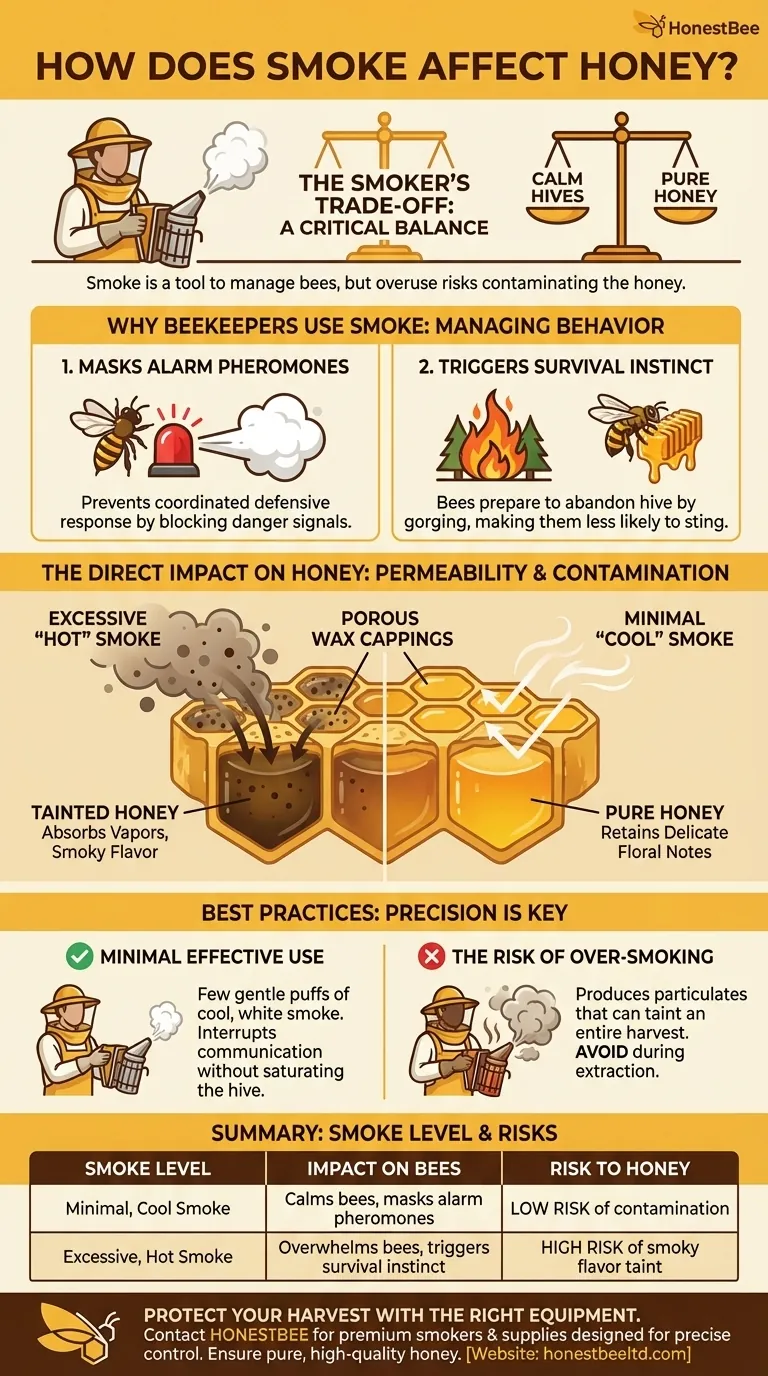In short, yes, smoke can affect honey. While small, infrequent puffs of smoke used during routine hive inspections are unlikely to have a noticeable impact, excessive smoke can absolutely contaminate the final product. The permeable nature of honeycomb cappings allows them to absorb vapors, and over-smoking can taint the honey with a distinct smoky flavor.
The core principle to understand is that smoke is a tool with a critical trade-off. It is used to manage bee behavior for safer hive inspections, but its overuse directly risks compromising the purity and flavor of the honey you harvest.

Why Beekeepers Use Smoke: Managing Bee Behavior
To understand the risk to honey, it's essential to first understand why smoke is used at all. It is a fundamental tool in beekeeping because it effectively alters bee behavior through two primary mechanisms.
Masking Alarm Pheromones
When guard bees sense a threat, they release an alarm pheromone. This chemical signal instantly alerts the rest of the colony to become defensive and agitated.
Smoke works by masking this scent. The particles in the smoke overwhelm the bees' ability to detect the alarm pheromone, effectively cutting off their primary communication channel for danger and preventing a coordinated defensive response.
Triggering a Survival Instinct
Smoke also triggers a deeper, instinctual response related to a forest fire. The bees' immediate reaction is to prepare for the possibility of abandoning their hive.
To do this, they begin to gorge on honey, loading up on food reserves for the potential journey. This has a convenient side effect for the beekeeper: a bee with a full abdomen has difficulty bending it to sting, making the entire colony more docile.
The Direct Impact of Smoke on Honey
While smoke pacifies bees, the very properties that make it effective also pose a risk to the honey they produce. The impact is a simple matter of chemistry and physics.
The Permeability of Honeycomb Cappings
The wax cappings that seal finished honey cells are not a perfect, impermeable barrier. They are slightly porous and can absorb volatile compounds from the air inside the hive.
From Vapor to Flavor Contamination
When a hive is filled with heavy smoke, these airborne particles and aromas can pass through the wax cappings and into the honey itself.
This directly alters the honey's volatile characteristics, infusing it with a smoky flavor and aroma that masks the delicate floral notes.
Understanding the Trade-offs: Calm vs. Purity
Using a smoker is a balancing act. The goal is to achieve a calm, manageable hive without damaging the product you are working to protect.
The Risk of Over-Smoking
The most common mistake is using too much smoke. This is especially damaging during honey extraction, when large numbers of frames with capped honey are exposed.
Excessive or "hot" smoke from a poorly managed smoker produces more particulates and can easily taint an entire harvest.
The Goal: Minimal Effective Use
Experienced beekeepers learn to use smoke with precision. A few gentle puffs of cool, white smoke at the hive entrance and under the cover is often all that is needed.
The objective is to use the absolute minimum amount required to keep the bees calm, ensuring their communication is interrupted without saturating the hive environment.
Applying This to Your Beekeeping Practice
Your approach to using smoke should align directly with your goals for the hive and its products.
- If your primary focus is preserving the pure, raw flavor of your honey: Use smoke as sparingly as possible, especially when working with honey supers that are close to being harvested.
- If your primary focus is safe and efficient hive management: Recognize smoke as an indispensable tool for preventing stings and reducing bee stress, but always prioritize using minimal amounts of cool smoke.
Ultimately, mastering the smoker is about using it as a precise instrument, not a blunt tool, ensuring both a safe apiary and a pure harvest.
Summary Table:
| Smoke Level | Impact on Bees | Risk to Honey |
|---|---|---|
| Minimal, Cool Smoke | Calms bees, masks alarm pheromones | Low risk of contamination |
| Excessive, Hot Smoke | Overwhelms bees, triggers survival instinct | High risk of smoky flavor taint |
Protect Your Harvest with the Right Equipment
Mastering the smoker is key to producing pure, high-quality honey. At HONESTBEE, we supply commercial apiaries and beekeeping equipment distributors with premium, reliable smokers and beekeeping supplies designed for precise control. Ensure your honey retains its delicate floral notes while maintaining a safe, manageable apiary.
Contact HONESTBEE today to discuss your wholesale needs and elevate your beekeeping operation.
Visual Guide

Related Products
- Stainless Steel Honey Bee Smoker Hive and Honeycomb Smoker for Beekeeping
- Economy Galvanized Beekeeping Honey Bee Smoker for Wholesale
- European Stainless Steel Bee Smoker for Honey Bee Hive
- Premium Traditional Copper Bee Smoker with Bellows
- Professional Bee Smoker with Elongated Spout and Durable Bellows for Beekeeping
People Also Ask
- What is the primary purpose of using smoke in beekeeping? Calm Bees for Safer Hive Management
- What is the purpose of a bee smoker and how should it be used? A Guide to Calm, Safe Hive Inspections
- What happens to bees when they sense smoke? Unlock the Secret to Calm Hive Inspections
- What is a Smoker and how is it used in beekeeping? The Essential Tool for Calm, Safe Hive Inspections
- What is the proper technique for lighting a bee smoker? Master the Layered Fire Method for Calm Hives



















